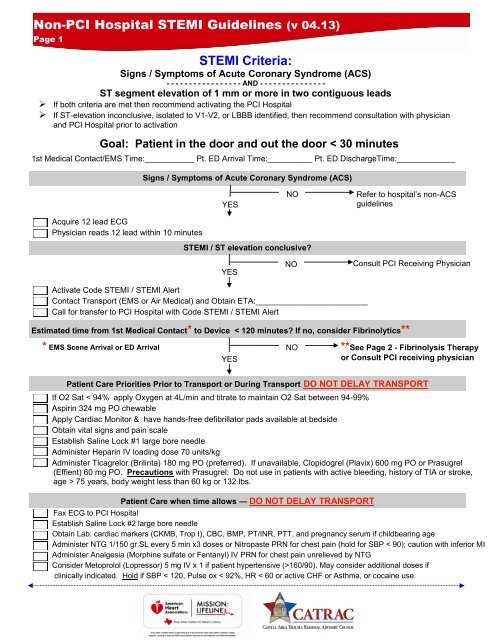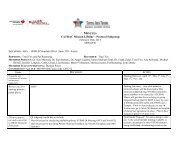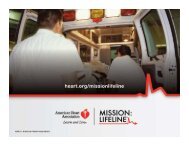Non-PCI Hospital STEMI Guidelines STEMI Criteria
Non-PCI Hospital STEMI Guidelines (v 04.13) STEMI ... - CATRAC
Non-PCI Hospital STEMI Guidelines (v 04.13) STEMI ... - CATRAC
Create successful ePaper yourself
Turn your PDF publications into a flip-book with our unique Google optimized e-Paper software.
<strong>Non</strong>-<strong>PCI</strong> <strong>Hospital</strong> <strong>STEMI</strong> <strong>Guidelines</strong> (v 04.13)<br />
Page 1<br />
<strong>STEMI</strong> <strong>Criteria</strong>:<br />
Signs / Symptoms of Acute Coronary Syndrome (ACS)<br />
- - - - - - - - - - - - - - - - - AND - - - - - - - - - - - - - - -<br />
ST segment elevation of 1 mm or more in two contiguous leads<br />
‣ If both criteria are met then recommend activating the <strong>PCI</strong> <strong>Hospital</strong><br />
‣ If ST-elevation inconclusive, isolated to V1-V2, or LBBB identified, then recommend consultation with physician<br />
and <strong>PCI</strong> <strong>Hospital</strong> prior to activation<br />
Goal: Patient in the door and out the door < 30 minutes<br />
1st Medical Contact/EMS Time:___________ Pt. ED Arrival Time:__________ Pt. ED DischargeTime:_____________<br />
Signs / Symptoms of Acute Coronary Syndrome (ACS)<br />
YES<br />
NO<br />
Refer to hospital’s non-ACS<br />
guidelines<br />
Acquire 12 lead ECG<br />
Physician reads 12 lead within 10 minutes<br />
<strong>STEMI</strong> / ST elevation conclusive?<br />
YES<br />
NO<br />
Consult <strong>PCI</strong> Receiving Physician<br />
Activate Code <strong>STEMI</strong> / <strong>STEMI</strong> Alert<br />
Contact Transport (EMS or Air Medical) and Obtain ETA:_________________________<br />
Call for transfer to <strong>PCI</strong> <strong>Hospital</strong> with Code <strong>STEMI</strong> / <strong>STEMI</strong> Alert<br />
Estimated time from 1st Medical Contact* to Device < 120 minutes? If no, consider Fibrinolytics**<br />
* EMS Scene Arrival or ED Arrival<br />
YES<br />
NO<br />
**See Page 2 - Fibrinolysis Therapy<br />
or Consult <strong>PCI</strong> receiving physician<br />
Patient Care Priorities Prior to Transport or During Transport DO NOT DELAY TRANSPORT<br />
If O2 Sat < 94% apply Oxygen at 4L/min and titrate to maintain O2 Sat between 94-99%<br />
Aspirin 324 mg PO chewable<br />
Apply Cardiac Monitor & have hands-free defibrillator pads available at bedside<br />
Obtain vital signs and pain scale<br />
Establish Saline Lock #1 large bore needle<br />
Administer Heparin IV loading dose 70 units/kg<br />
Administer Ticagrelor (Brilinta) 180 mg PO (preferred). If unavailable, Clopidogrel (Plavix) 600 mg PO or Prasugrel<br />
(Effient) 60 mg PO. Precautions with Prasugrel: Do not use in patients with active bleeding, history of TIA or stroke,<br />
age > 75 years, body weight less than 60 kg or 132 lbs.<br />
Patient Care when time allows — DO NOT DELAY TRANSPORT<br />
Fax ECG to <strong>PCI</strong> <strong>Hospital</strong><br />
Establish Saline Lock #2 large bore needle<br />
Obtain Lab: cardiac markers (CKMB, Trop I), CBC, BMP, PT/INR, PTT, and pregnancy serum if childbearing age<br />
Administer NTG 1/150 gr.SL every 5 min x3 doses or Nitropaste PRN for chest pain (hold for SBP < 90); caution with inferior MI<br />
Administer Analgesia (Morphine sulfate or Fentanyl) IV PRN for chest pain unrelieved by NTG<br />
Consider Metoprolol (Lopressor) 5 mg IV x 1 if patient hypertensive (>160/90). May consider additional doses if<br />
clinically indicated. Hold if SBP < 120, Pulse ox < 92%, HR < 60 or active CHF or Asthma, or cocaine use.
<strong>Non</strong>-<strong>PCI</strong> <strong>Hospital</strong> <strong>STEMI</strong> <strong>Guidelines</strong> (v 04.13)<br />
Page 2<br />
Fibrinolytic Therapy<br />
Goal: Patient in Door to Needle Time < 30 minutes<br />
Is Estimated Time from First Medical Contact (EMS or Door) to<br />
Device/Reperfusion > 120 minutes?<br />
NO<br />
Return to Page 1<br />
YES<br />
Reperfusion Checklist MUST BE COMPLETED Prior to Administration of Fibrinolytic Therapy<br />
ABSOLUTE contraindications to Fibrinolytic Therapy<br />
RELATIVE contraindications to Fibrinolytic Therapy<br />
Active internal bleeding or bleeding diathesis Yes No Active internal bleeding in past 2-4 weeks Yes No<br />
Any prior Intracranial Hemorrhage Yes No Prior exposure to Fibrinolytics Yes No<br />
Allergy to Fibrinolytics Yes No Severe hepatic and renal dysfunction Yes No<br />
Ischemic stroke < 3 months (exception: acute<br />
ischemic stroke within 4.5 hours)<br />
Yes No Recent GI bleed or active Ulcer disease Yes No<br />
Known malignant intracranial neoplasm Yes No Traumatic or prolonged CPR > 10 minutes Yes No<br />
Known/suspected aortic dissection or<br />
aneurysm<br />
Yes No Current use of anticoagulants Yes No<br />
Cerebral aneurysm or AVM Yes No History of prior ischemic stroke > 3 months Yes No<br />
Trauma / Surgery (Intra-cranial<br />
Or Intra-spinal) < 3 months<br />
Significant closed-head or facial trauma<br />
within < 3 months<br />
Yes No Major surgery or trauma within 3 weeks Yes No<br />
Yes No Pregnancy or early postpartum Yes No<br />
Severe hypertension unresponsive to<br />
emergency therapy<br />
(SBP > 180 mmHg or DBP > 110 mmhG)<br />
Yes<br />
No<br />
Significant Hypertension on presentation<br />
(SBP < 180 mmHg or DBP < 110 mmHg)<br />
Yes<br />
No<br />
Known structural cerebral vascular lesion<br />
(e.g. Arterlovenous malformation)<br />
Yes<br />
No<br />
History of chronic, severe, poorly<br />
controlled hypertension<br />
Yes<br />
No<br />
Dementia Yes No<br />
Known intracranial pathology not<br />
covered in Absolute Contraindications<br />
Yes<br />
No<br />
<strong>Non</strong>-compressible vascular punctures Yes No
<strong>Non</strong>-<strong>PCI</strong> <strong>Hospital</strong> <strong>STEMI</strong> <strong>Guidelines</strong> (v 04.13)<br />
Page 3<br />
Fibrinolytic Administration <strong>Guidelines</strong><br />
Goal: Patient in Door to Needle Time < 30 minutes<br />
Has patient experienced chest discomfort for greater than 12 hours?<br />
NO<br />
YES<br />
Consult <strong>PCI</strong> receiving physician<br />
Are there contraindications to Fibrinolytic? (see Page 2)<br />
NO<br />
YES<br />
Primary Drug Treatment Plan<br />
Consult <strong>PCI</strong> receiving physician<br />
Fibrinolytic should be given in a dedicated IV line. Flush line before and after administration of medication<br />
Tenecteplase (TNKase) IV over 5 seconds:<br />
***(If unable to give TNKase, give Reteplase (Retavase) per Alternative Drug Treatment Plan on page 4)***<br />
Patient Weight<br />
TNKase Reconstituted<br />
kg lbs mg mL<br />
<strong>Non</strong>-<strong>PCI</strong> <strong>Hospital</strong> <strong>STEMI</strong> <strong>Guidelines</strong> (v 04.13)<br />
Page 4<br />
Fibrinolytic Administration <strong>Guidelines</strong><br />
Goal: Patient in Door to Needle Time < 30 minutes<br />
Has patient experienced chest discomfort for greater than 12 hours?<br />
NO<br />
YES<br />
Consult <strong>PCI</strong> receiving physician<br />
Are there contraindications to Fibrinolytic? (see Page 2)<br />
NO<br />
YES<br />
Consult <strong>PCI</strong> receiving physician<br />
***Alternative Drug Treatment Plan***<br />
Reteplase (Retavase) 10 Units IV over 2 minutes x 2 at 30-minute intervals<br />
1st dose given at:_____________<br />
2nd dose given at:_______________<br />
Unfractionated Heparin bolus 60 IU/kg IV (maximum 4,000 IU)<br />
If O2 Sat





